The beauty of EVs is that they’re ridiculously simple to operate. In order to stand out, automakers are piling on the power and features, helping to justify exorbitant price tags in the face of middling range. The Audi E-Tron GT and RS E-Tron GT are the latest entries in a burgeoning luxury EV segment, promising all the trappings of a six-figure machine combined with the simplicity of an electric vehicle. Or in this case, the German definition of simple.
Full disclosure: Audi provided me with a comfy hotel room, delicious food, and several fully-charged E-Tron GTs for me to drive.
What is it?
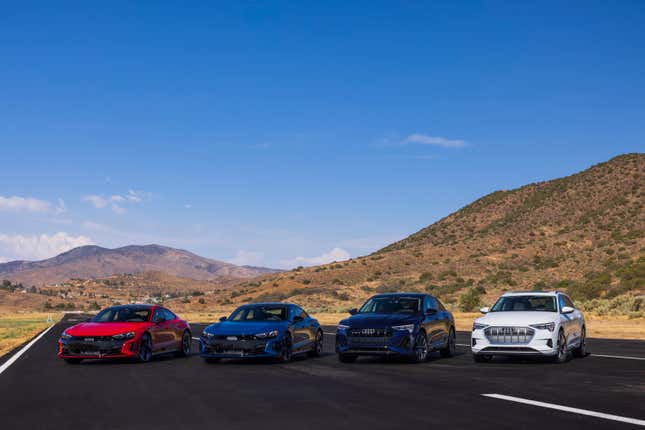
The E-Tron GT and RS E-Tron GT are Audi’s third and fourth fully-electric vehicles. Based on the J1 platform which also underpins the Porsche Taycan, the E-Tron GT duo feature four-doors, five seats, and — despite the swoopy profile — a trunk in the back. Audi previously used the GT moniker on the Coupe, which was sold here from 1984-1988.
About the rest of the name: Audi has committed to incorporating “E-Tron” into the branding of all of its future electric cars, so get ready to see Q4 E-Tron, A6 E-Tron, etc. Personally, I think something like “Taycan” is a much better solution, but with so many automakers adopting the use of E to signify electric cars (with the exception of Jaguar), it looks like the nomenclature will continue to proliferate — until the majority of Audi’s offerings are electric, at least.
Specs To Know

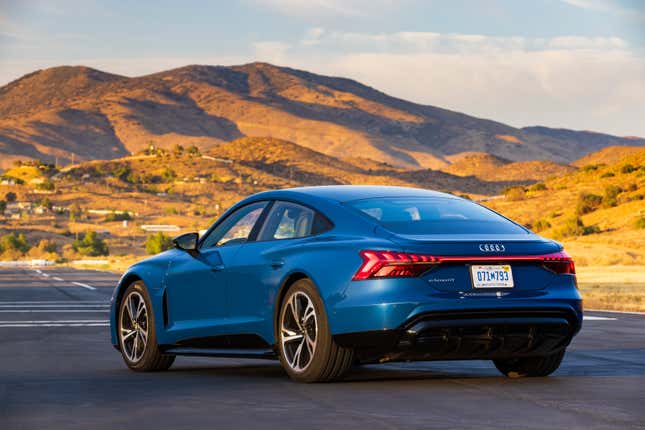
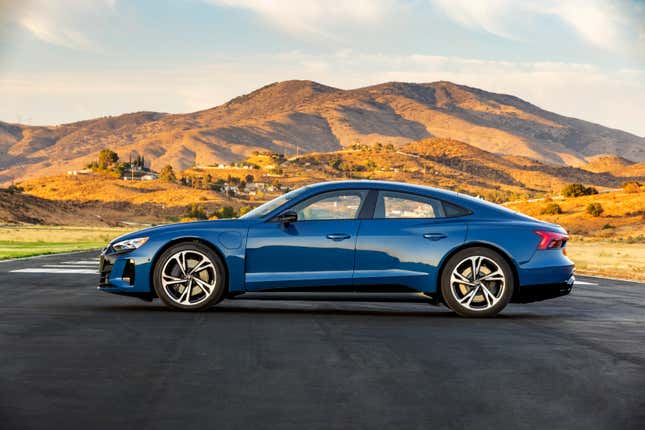
The Audi E-Tron GT has a starting price of $100,945, which nets you a 496-horsepower dual-motor powertrain, 14-way heated vegan seats, three-chamber air suspension, and 20-inch wheels. If you desire more punch, the RS E-Tron GT begins at $140,945, which adds nearly a hundred more horsepower as well as a heaping dose of carbon-fiber bits, a Bang and Olufsen sound system, and surface-coated brakes. (They’re just like the ones first seen on the 2019 Porsche Cayenne.) If exclusivity is your thing, a Year One Package ($20,350) adds even more carbon fiber, a leather interior, and ceramic brakes behind 21-inch wheels.
The Drive

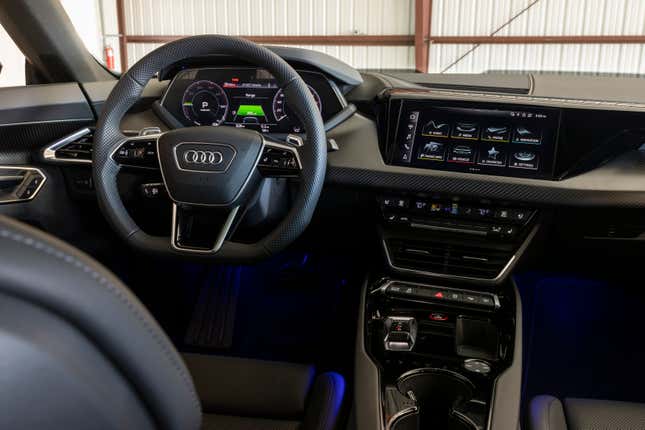
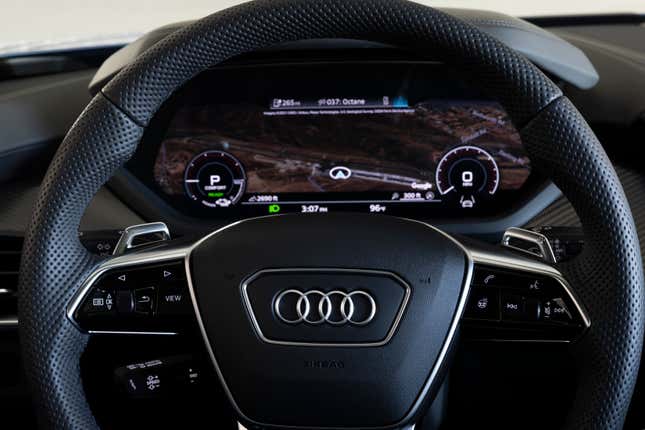
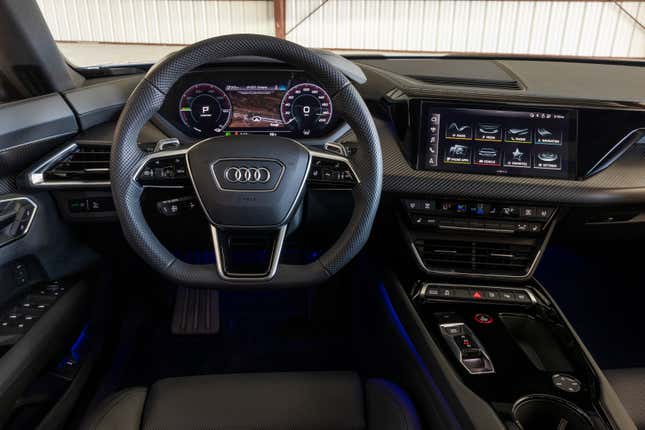
With an engine no longer hanging over the nose, the E-Tron duo features a near-perfect 50-50 weight distribution over the axles. This purpose-built electric chassis features battery packs fully tucked beneath the floor, allowing for a low center of gravity and a lower seating position. The result: a roofline that’s only four inches higher than the R8, and a slippery .24 Cd. By going electric, Audi has finally vanquished the front weight bias that’s been endemic to every quattro model for the past 40-odd years.
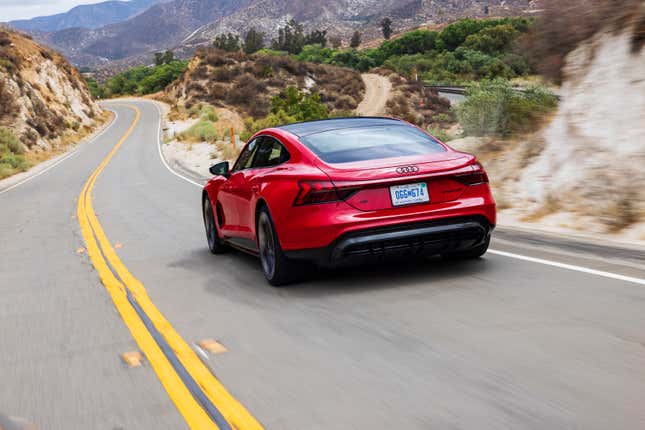
With that complication out of the way, all that rally-honed experience pays off in dividends. Despite a hefty curb weight, the E-Tron GT feels nimble in the corners. Turn-in is surprisingly precise and linear, without any of the numbness that’s normally found in a big Audi sedan. Go hard in a turn and the E-Tron GT willingly complies. The overall lack of engine noise means that initial tire squeal is more noticeable, though I’m guessing the compound of the Goodyear Eagle F1s are likely more culpable.
The E-Tron GT displays the same sort of inherent composure when the road straightens out, too, practically obviating the need to adjust drive settings through the Drive Select menu. The difference between the modes was so minimal that I ended up just leaving it in Dynamic for most of the drive. Even at its sportiest setting, the ride remained acceptable and the steering wasn’t too heavy. Honestly, Audi should really embrace the GT mission of this car and focus on dialing in a single setup that has the broadest appeal. In driving it back-to-back with the RS E-Tron GT, I found its inputs to be just a little sharper, though I have the same opinion on the drive modes.

Where the RS really shines, however, is in the strength of its powertrain. EVs are famous for their instant torque, and the RS has 612 lb-ft of it. The acceleration is simply always there when you need it. Engaging launch control unlocks a full 637 hp and is like having your own personal theme park ride. Disengage traction control, activate Dynamic mode, mash both pedals, then let ‘er rip. The experience is otherworldly. As the RS rockets forward, it’s as if it’s sucking the electrons straight out of your body to fuel its forward momentum.
What’s Good
Molecule-rearranging thrust aside, the tenacious grip of all four wheels makes this power extremely usable. Merely point the car in the direction you want to go and the E-Tron GT happily complies. If this car were to have a diesel-like range, you’d easily enjoy every single mile traveled, and emerge relaxed and refreshed. Audi has nailed the GT concept in electric form.
That pleasure extends to the passengers as well. While five people is pushing the limits of comfort, the E-Tron GT is more than capable of transporting a party of four in serene velocity. While the trunk only offers 9.8 cubic feet of room (a Corolla offers 13.1, for instance), the space is extremely usable. Luggage for an extended weekend will easily fit. The rear seats fold down for even more practicality.
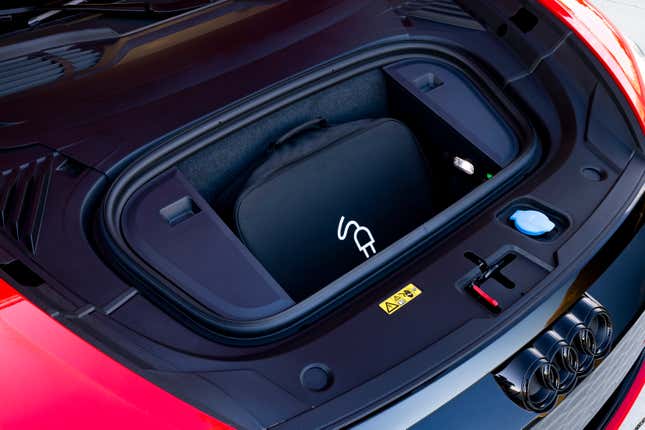
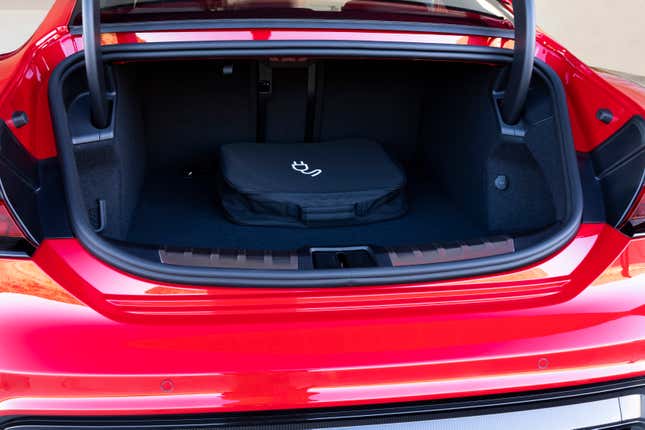
I didn’t get a chance to personally charge either of my test cars, but the J1 platform’s 800V architecture allows for up to 270 kW Level 3 DC Fast charging. That means you’ll be able to replenish 180 miles of range to the 93 kWh battery in about 22 minutes. Based on my prior experience with the Taycan, this rapid charging is indeed possible in the real world. Ports on either fender of the E-Tron GT make hooking up more convenient, and unlike the finicky electric sliders on the Taycan, the E-Tron GT’s doors simply require a push to open and close. Audi is also offering three years of free charging at Electrify America stations, which is a pretty sweet deal.
What’s Weak

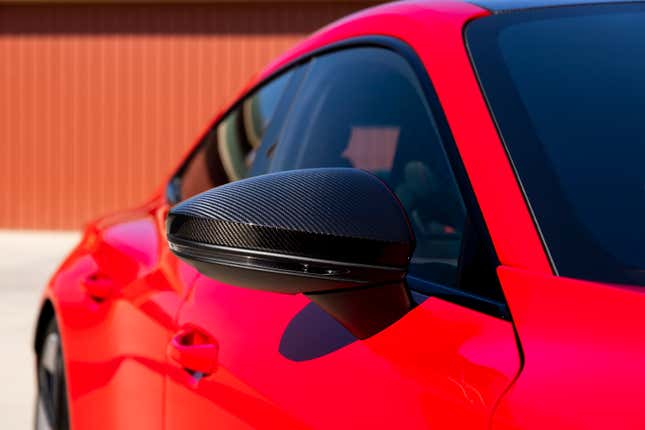
On the other hand, the EPA rating of 238 miles (232 for the RS) falls short given how much you’re spending. This is more an issue of modern battery technology, but other cars that cost half as much as the Audi offer just as much range — or better. I’d gladly trade some face-flattening acceleration for a couple dozen more miles out of the battery. Like I said, this is a car I’d drive 500 miles in a single stint without complaint. If only that were possible.
It’s also maddening that Audi doesn’t fully embrace the unique nature of the EV driving experience. A true regen mode isn’t available, which makes one-pedal driving impossible. You can select a small amount of regen by using the steering wheel paddles, but the effect is akin to opening the door and dragging your foot on the pavement. Also, why are those paddles there in the first place? (Leave that kind of parts-bin malfeasance to GM, who couldn’t be bothered to remove them from manual-equipped Camaros and Corvettes.)
In fact, the subjective freedom of choice is one of my main gripes with the E-Tron GT cars. All non-RS models feature a glass roof without any shade. No amount of air conditioning can stave off the piercing glare of the high-noon sun. And while there are plenty of adjustments you can make to the car that don’t significantly change the driving experience, Audi prefers to make the decision for you when it comes to things that actually matter, like the lack of a regen option. It was also disconcerting to not be able to move the steering wheel when the ignition was on and the car was in Park, and poking through the MMI menus felt unnecessarily complicated. I only discovered by accident that the RS had massaging seats — a feature that’s buried three layers deep.
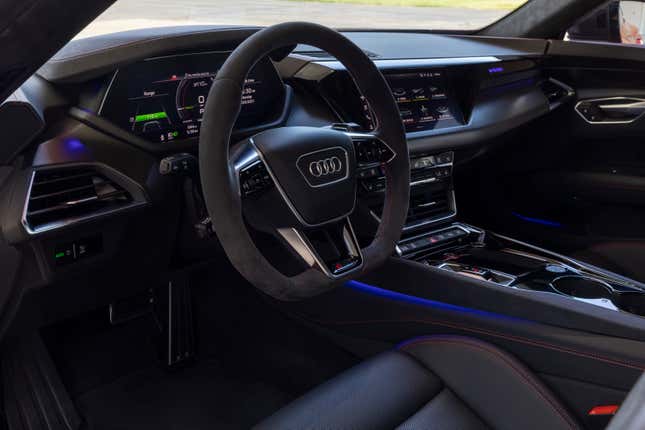
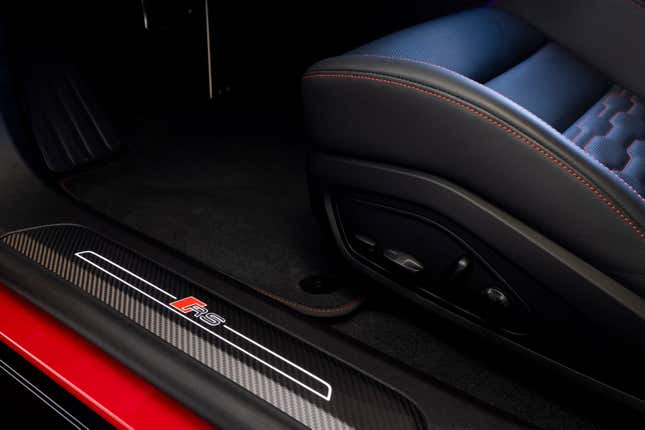
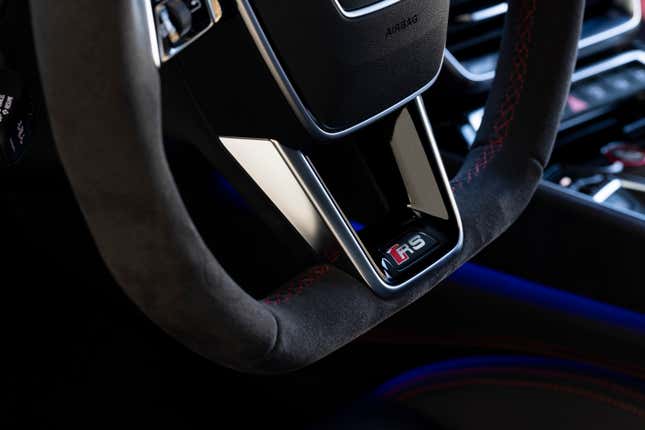
I’m also increasingly curious about the direction of Audi design. During my review of the RS6 Avant, I bemoaned the lack of subtlety that used to be an Ingolstadt hallmark. With the E-Tron GT, it feels like Audi has completely forgotten this concept. From some angles, the shape has a purposeful strength to it, especially on the side profile. But the wraparound taillights look cartoonishly large, dominating the wide rear flanks rather than emphasizing them. And since EVs don’t need a front grille in the traditional sense, automakers have been experimenting with all sorts of fascias. The big black mask on the E-Tron GT looks cheap and unfinished. Audi must have thought so too, because shortly before production. A body-color front end was added as a $350 option. I have yet to see it in person, but I hope the color contrast is integrated better than it is on the 2022 Porsche Macan GTS or Mini.
The Verdict

While the original E-Tron was all about introducing electrification to the Audi brand, the E-Tron GT and RS E-Tron GT signal that Audi is serious about adding electric performance to the portfolio. The driving experience is wholly satisfying, and I’m glad that Audi has successfully ported over its Quattro philosophy intact. This feels every inch a large, powerful German saloon capable of maintaining triple-digit speeds in total comfort. Though it nearly captures the spirit of a Grand Tourer, a touch more simplification and sophistication wouldn’t hurt. Give it some long legs to go along with this stellar performance, and then the E-Tron GT lineup will truly go the distance.
Derek Powell is a producer on Top Gear America who normally makes good life decisions and also has a 2005 Audi Allroad as a daily driver. We all contain multitudes. Find him on Twitter and Instagram.